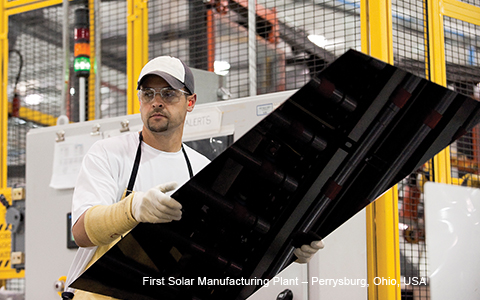First Solar's latest generation of PV keeps it on path to low-cost solar
 As the year comes to a close, First Solar introduced its latest, more efficient line of photovoltaics. It’s the latest for a company that’s been leading the way in thin-film PV and building some of the largest PV plants in the world.
As the year comes to a close, First Solar introduced its latest, more efficient line of photovoltaics. It’s the latest for a company that’s been leading the way in thin-film PV and building some of the largest PV plants in the world.
The latest release of First Solar’s modules are 92.5 watts. The newest modules is its Series 3 FS-392 and it retains all of its existing IEC certifications and UL listings for the Series 3 family, including UL listing for 1000-volt systems. That’s still a lot less wattage than some of the company’s competitors, like silicon efficiency leader SunPower, which has a 250 watt module, but because First Solar uses a different, less expensive type of semiconductor, cadmium telluride (CdTe) than SunPower and many other PV manufacturers, its cost-per-watt is competitive with other companies in the photovoltaic manufacturing business. “We are continuously refining our production process to achieve higher efficiency/lower cost,” said spokesperson Alan Bernheimer.
The company has produced more efficient modules and is shipping modules at volume that are 12.7 percent efficient but it has produced modules up to 14.4 percent efficient. “The 14.4 percent module was a record that we announced early this year,” Bernheimer said. “We report average efficiency for all modules shipped per quarter, the latest being 12.7 percent for Q3 2012.”
With the release of the newest modules the company also reaffirmed its low-temperature coefficient as some of the best in class available. Basically as all photovoltaics heat up, their performance is impacted. “CdTe has a lower temperature coefficient that cSi, meaning that it’s performance declines more slowly as temperatures rise,” Bernheimer said. So, while the company’s modules may be less efficient than competitors’ in standard test conditions, in the field they may outperform them, particularly in desert and other hot conditions.
The new modules show that First Solar is executing on its plan to continually reduce the costs of its modules, which the company puts at about 23 cents per watt for a system in 2012. By 2016 it anticipates its system costs will be closer to 5 cents per watt for modules. At that rate its systems could deliver a levelized cost of electricity at rates lower than 10 cents per watt, making it more competitive with conventional electric generation in the U.S. and lower than in most of the rest of the world.



